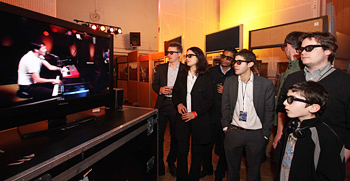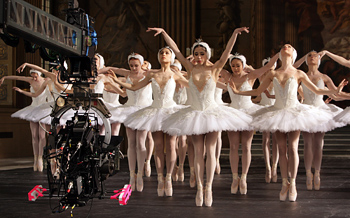3D to the Home Begins in the U.K.

In April, Sky's live broadcast of a Keane concert in 3D was the first of its kind in EuropeLOS ANGELES
In July, BSkyB announced that it will begin delivering full stereoscopic 3D programming over one of its Sky satellite channels to the U.K., including England, Northern Ireland, Scotland and Wales next year. As Europe's most successful HD service and after having doubled the number of its HD customers in just the past year, the Murdoch owned media company is capitalizing on the fact that its more than 1.3 million subscribers who have upgraded to Sky's high definition Sky+HD set top boxes already have the ability to receive 3D home delivery.
CHICKEN AND EGG
"This new 3D service will be in addition to our 33 existing channels of prime HD programming," said Gerry O'Sullivan, Sky's Director of Strategic Product Development, "to provide an experience that is comparable to what audiences have come to expect from a 3D cinema experience. But the main point is that we will be achieving this while using our current HD infrastructure end-to-end."
The Sky+HD signal will be a side-by-side, 1080i spatially compressed stereoscopic 3D delivery, decoded at the receiver's site and viewed with circularly polarized passive lenses. Although over the past year BSkyB's experiments with 3D home satellite delivery were limited to the Hyundai 3DTV-ready sets which have onboard 3D decoders built in, BSkyB is still talking with several major 3DTV-ready set manufacturers such as JVC and LG that can use outboard decoders. By the time 3D delivery begins sometime next year, they expect many other HD set makers will also be providing home 3D displays that can use their system.

Sky films the English Ballet's production of "Swan Lake" in 3D. "Until now it has been a chicken and egg situation with 3D display manufacturers waiting for sufficient content to generate market demand," O'Sullivan said. "BSkyB is in the unique position of being both a broadcaster and a platform for developing 3D content."
BSkyB's 3D tests have already successfully satcast a Keane concert live from Abbey Road Studios, a special performance of "Swan Lake" by the English National Ballet, several major soccer matches and even Jamaican sprinter Usain Bolt breaking a world 150 meter record on a specially designed track at Manchester's Deansgate during the Bupa Great City Games.
"Since the output of our Sky+HD output is a normal HDMI high definition signal, we feel that almost any 3D-ready HD set could display it with simple decoding technology," O'Sullivan said. "The only additional requirement will be positioning a polarizing filter on the front of the screen that works in tandem with the polarized lenses in the glasses."
There is a growing demand for 3D in the home in the United States, but so far attempts have been limited to various forms of anaglyph or color separation technologies that can be presented in a single video stream. Both the Disney Channel and Starz Entertainment cablecast the "Hannah Montana/Miley Cyrus Best of Both Worlds Concert Tour" in anaglyph in July 2008, and there were two commercials broadcast over the air by NBC during Super Bowl XLIII using ColorCode 3D. Currently, the Cox and Comcast cable systems offer several feature films in various forms of anaglyph over their VOD service while Shaw Cable systems is using ColorCode 3D for their on-demand customers. But true stereoscopic 3D home delivery either over the air, on disk, or through a subscription service seems a ways off in the future.
IS IT FOR BROADCASTERS?
The Advanced Television Systems Committee which oversaw the development of HDTV standards adopted by the FCC in 1996, has been looking into the potential of terrestrial 3D broadcasting. "We have been considering whether it is advisable for domestic broadcasters to offer 3DTV considering their bandwidth limitations and the demands of other HD and SD services," said Mark Richer, president of the ATSC. "We are in the final stages of defining the first version of our mobile TV standards, and the question is whether there will be enough market demand for broadcasters to provide stereoscopic 3D to consumers. It is an ongoing question, but at the moment we have decided it would be premature to start standardization work until we see how the market develops."

Mark Richer, president, ATSC On the 3D mastering side, a task force from SMPTE gave its report during the 2009 NAB Show and since then work statements have been developed to start standardization. At the June SMPTE block meetings a 3D Home Master Technology Committee approved work statements to form a working group to actually begin writing documents on the 3D image master, subtitles and closed captions, graphical overlays, and the metadata associated with 3D to, among other things, play out 2D from a 3D image to make sure the two systems are compatible on a home display.
"We have filled almost all of the slots needed to complete this standardization effort," said Wendy Aylsworth, engineering vice president of SMPTE, "and we hope the actual work will commence starting in September. We are trying to keep in mind all the potential delivery systems so that all the data can be carried across all those distribution channels. One high priority for us is that any 2D set should be able to see any 3D broadcast. We hope to have the mastering standards published in about a year's timeframe."
ESPN is already experimenting with 3D presentations, including producing a stereographic 3D delivery of the USC-Ohio State football game on Sept. 12 to three 3D cinemas in Columbus, Ohio, Hartford, Conn., and Hurst, Texas. Perhaps most importantly, the game was also seen at Galen Center on the USC campus and the ESPN Zone at LA Live on consumer-grade 3DTV sets that intentionally simulate a home viewing experience.
"This is a 100 percent research and development project," said Anthony Bailey, vice president of emerging technologies for ESPN, "to determine if people will enjoy the game both in theaters and on consumer electronics devices in a setting like their living room. If we find that people will come out to watch this presentation, potentially 3D has a future here."
The professional video industry's #1 source for news, trends and product and tech information. Sign up below.
